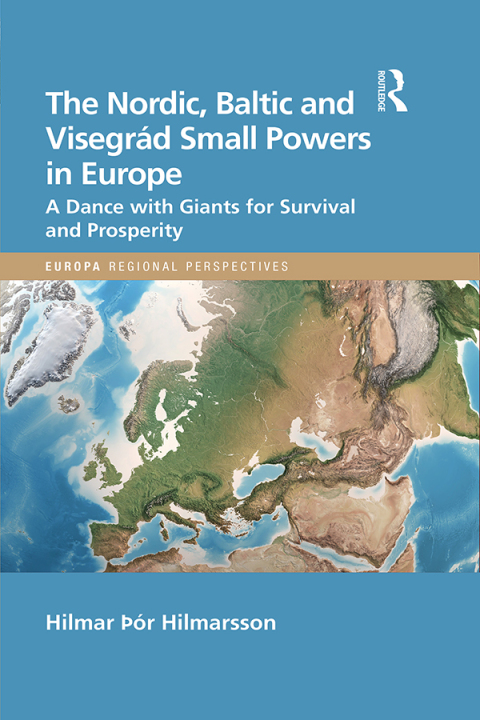Description
Efnisyfirlit
- Cover
- Half Title
- Series Page
- Title Page
- Copyright Page
- Table of Contents
- List of figures
- List of tables
- List of boxes
- The author
- Acknowledgements
- Abbreviations and acronyms
- Introduction
- References
- 1. The costs and benefits of European integration, and the challenges of NATO membership for small powers
- European integration and NATO membership
- Different levels of European integration
- Some benefits and costs resulting from European integration
- The euro area: costs and benefits of membership
- Proximity with Russia and European integration
- US-backed NATO security: the US security umbrella
- NATO versus the Warsaw Pact
- From unipolarity to multipolarity: the rise of China, Russian recovery post-Soviet Union and the Chinese-Russian partnership
- Continued US dominance in Europe and European cooperation with China
- Major powers in Europe, Germany and France
- What does this mean for small states/powers in Europe?
- The different approaches to European integration and NATO membership
- The Nordic countries
- The Baltic states
- The Visegrád countries
- References
- 2. Participation in global and regional institutions and international relations theories
- Participation in global institutions
- Participation in regional institutions
- Overseas development assistance
- Participation and priorities in bilateral development cooperation
- International organizations and the liberal world order
- International relations theory: theoretical framework
- The EU, NATO and liberalism
- Realism versus liberal institutionalism
- International institutions and small states/powers
- References
- 3. Some small power alliances in Europe
- The Baltic, Nordic and the Visegrád groups
- Nordic cooperation2
- Baltic cooperation
- Visegrád cooperation10
- The Visegrád group today
- The structure of Visegrád cooperation
- The role of states in the international system
- Meetings between the Nordic, Baltic and Visegrád groups
- Siding with the US or China?
- Lithuania’s tensions with Russia and China and the blind reliance on the US
- Can the Baltic states rely on the US for their defence? Can they rely on the EU?
- References
- 4. Economic and social performance after the 2008–09 global financial crisis and during the COVID-19 pandemic
- Unemployment
- Market economy versus Keynesian welfare state: the Nordic versus the Baltic model
- The Nordic welfare model and collective risk sharing
- The Baltic neoliberal revolt against the welfare state
- Visegrád group
- Social justice in the Baltic, Nordic and Visegrad countries
- The performance of welfare systems: the Baltic States lagging behind
- Income inequality, poverty and social exclusion in the Baltic, Nordic and the Visegrád groups during the past decade
- Poverty or social exclusion?
- Health care expenditure and COVID-19 cases and deaths
- Concluding remarks
- References
- 5. Great powers influencing Europe in a changing world: From bipolar to unipolar to multipolar
- From a bipolar to a unipolar to a multipolar world: how does this affect Europe?
- China’s growing interest in Europe and the US pivot to Asia
- Small states’ behaviour in a multipolar world
- Small states’ strategy in a multipolar world
- An Icelandic moment for Lithuania
- References
- 6. The US and its role in Europe: Is the transatlantic alliance viable and feasible?
- US leadership role after the Second World War
- The fall of the Soviet Union and US influence on the former Soviet satellite states and republics
- The rise of China and a stronger Russia
- How viable is the transatlantic link?
- How should European small powers react to this change?
- References
- 7. The rise of China and its growing economic and political interest in Europe
- The rise of China and the relative decline in US supremacy
- Alliances against China
- The China-Russia alliance
- Some other major alliances with and without China
- United Nations Security Council, NATO and the great power rivalry
- How can Europe deal with this challenge? How should Europe manage its relations with China vs the US?
- References
- 8. Sharing a border with Russia: Ukraine and the challenge of EU and NATO expansion
- Introduction
- Ukraine
- Post-Soviet Union economic performance and productivity
- Internal and external (im)balances in Ukraine and Poland
- Integration with the West with the support of the EU, NATO and the US, and the subsequent conflict with Russia and full-scale war
- The effect of weak governance and corruption
- Outward migration and unemployment
- Discussion
- Concluding remarks
- References
- 9. How can Europe move forward post-COVID-19 and Brexit?
- Challenges ahead for the European Union
- The euro and the fragility of some euro area economies
- Fiscal discipline in the euro area
- Populist movements and the migration crisis
- Brexit
- Can Brexit result in further disintegration?
- More flexible fiscal rules in the euro area?
- Fiscal deficit or general government net lending/borrowing
- General government gross debt
- References
- 10. Dancing with giants: What can small powers do to maintain their economic and political sovereignty in a multipolar world?
- Great powers in a multipolar world
- Small states and small state alliances in a multipolar world
- Why are great powers opportunistic and unreliable?
- The risk of relying on great powers
- References
- 11. Conclusion and policy implications
- The status quo scenario
- Strengths
- Weaknesses
- Opportunities
- Threats
- Pivot to China scenario
- Strengths
- Weaknesses
- Opportunities
- Threats
- Pragmatic scenario
- Strengths
- Weaknesses
- Opportunities
- Threats
- Security in the Baltic states, the Nordic countries and the Visegrád group: strengths and weaknesses
- Baltic states
- Nordic countries
- Visegrád group
- References
- Index






Reviews
There are no reviews yet.